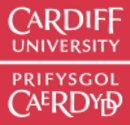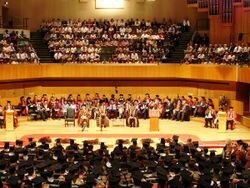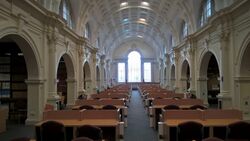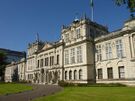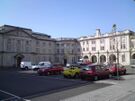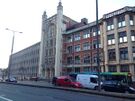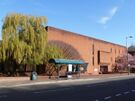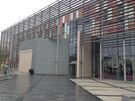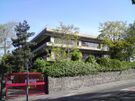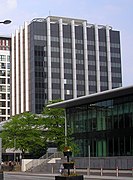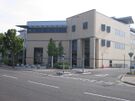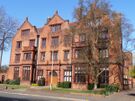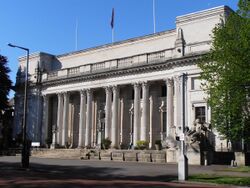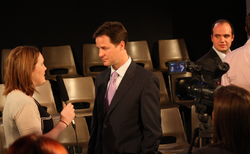Cardiff University
Topic: Organization
 From HandWiki - Reading time: 24 min
From HandWiki - Reading time: 24 min
Welsh: Prifysgol Caerdydd | |||||||||||||||||||||||
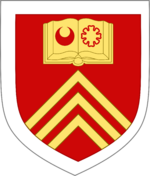 Coat of arms of Cardiff University | |||||||||||||||||||||||
Former names |
| ||||||||||||||||||||||
|---|---|---|---|---|---|---|---|---|---|---|---|---|---|---|---|---|---|---|---|---|---|---|---|
| Motto | Welsh: Gwirionedd, Undod a Chytgord[1] | ||||||||||||||||||||||
Motto in English | Truth, Unity and Concord[1] | ||||||||||||||||||||||
| Type | Public | ||||||||||||||||||||||
| Established |
| ||||||||||||||||||||||
| Endowment | £46.2 million (2023)[2] | ||||||||||||||||||||||
| Budget | £627.2 million (2022/23)[2] | ||||||||||||||||||||||
| Chancellor | Jenny Randerson[3] | ||||||||||||||||||||||
| Vice-Chancellor | Wendy Larner | ||||||||||||||||||||||
Academic staff | 3,400 (2021/22)[4] | ||||||||||||||||||||||
Administrative staff | 3,535 (2021/22)[4] | ||||||||||||||||||||||
| Students | 33,985 (2021/22)[5] | ||||||||||||||||||||||
| Undergraduates | 23,765 (2021/22)[5] | ||||||||||||||||||||||
| Postgraduates | 10,220 (2021/22)[5] | ||||||||||||||||||||||
| Location | , Wales [ ⚑ ] : 51°29′N 3°11′W / 51.49°N 3.18°W | ||||||||||||||||||||||
| Campus | Urban | ||||||||||||||||||||||
| Affiliations |
| ||||||||||||||||||||||
| Website | {{{1}}} | ||||||||||||||||||||||
Cardiff University (Welsh: Prifysgol Caerdydd) is a public research university in Cardiff, Wales. It was established in 1883 as the University College of South Wales and Monmouthshire and became a founding college of the University of Wales in 1893. It was renamed University College, Cardiff in 1972 and merged with the University of Wales Institute of Science and Technology in 1988 to become University of Wales College, Cardiff and then University of Wales, Cardiff in 1996. In 1997 it received degree-awarding powers, but held them in abeyance. It adopted the operating name of Cardiff University in 1999; this became its legal name in 2005, when it became an independent university awarding its own degrees.
Cardiff University is the only Welsh member of the Russell Group of research-intensive British universities.[6] Academics and alumni of the university have included two heads of state or government and two Nobel laureates. (As of 2023) the university's academics include 17 fellows of the Royal Society, 11 fellows of the Royal Academy of Engineering, seven fellows of the British Academy, 21 fellows of the Academy of Medical Sciences and 32 fellows of the Academy of Social Sciences.[7]
History
University college
The foundation of the university college in Cardiff that was to become Cardiff University was part of the Welsh university movement of the second half of the 19th century, which also led to the foundation of the colleges at Aberystwyth and Bangor (now Aberystwyth and Bangor universities) and the federal University of Wales. The movement began at a meeting in London in 1854 called by Hugh Owen, including leaders of Welsh theological colleges and members of parliament. This meeting discussed establishing university colleges in Wales along the same lines as the Queen's Colleges established the previous decade in Ireland, and produced a formal proposal, the "Outline of Constitution for Proposed Welsh Queen's Colleges".[8]
Discussions on the founding of a university college in South Wales were revived in 1879, when a group of Welsh and English MPs urged the government to consider the poor provision of higher and intermediate education in Wales and "the best means of assisting any local effort which may be made for supplying such deficiency."[9]
In August 1880, William Ewart Gladstone's government appointed a departmental committee to conduct "an enquiry into the nature and extent of intermediate and higher education in Wales", chaired by Lord Aberdare and consisting of Viscount Emlyn, Reverend Prebendary H. G. Robinson, Henry Richard, John Rhys and Lewis Morris.[10] The Aberdare Report, as it came to be known, took evidence from a wide range of sources and over 250 witnesses and recommended a college each for North Wales and South Wales, the latter to be located in Glamorgan and the former to be the established University College of Wales in Aberystwyth (now Aberystwyth University). The committee cited the unique Welsh national identity and noted that many students in Wales could not afford to travel to University in England or Scotland. It advocated a national degree-awarding university for Wales, composed of regional colleges, which should be non-sectarian in nature and exclude the teaching of theology.[11][12]
After the recommendation was published, Cardiff Corporation sought to secure the location of the college in Cardiff, and on 12 December 1881 formed a University College Committee to aid the matter.[13] There was competition to be the site between Swansea and Cardiff. On 12 March 1883, after arbitration, a decision was made in Cardiff's favour.[13] This was strengthened by the need to consider the interests of Monmouthshire, at that time not legally incorporated into Wales, and the greater sum received by Cardiff in support of the college, through a public appeal that raised £37,000 and a number of private donations, notably from the Lord Bute and Lord Windsor.[14][15] In April Lord Aberdare was appointed as the college's first president.[13] The possible locations considered included Cardiff Arms Park, Cathedral Road, and Moira Terrace, Roath, before the site of the Old Royal Infirmary buildings on Newport Road was chosen.[13]
The University College of South Wales and Monmouthshire opened on 24 October 1883 with courses in biology, chemistry, English, French, German, Greek, history, Latin, mathematics and astronomy, music, Welsh, logic and philosophy, and physics. It was incorporated by royal charter the following year; this was the first charter in Wales to allow the enrolment of women and to specifically forbid religious tests for entry.[15] John Viriamu Jones was appointed as the college's first principal at the age of 27. As the college was not an independent university and could not award its own degrees, it prepared its students for examinations of the University of London or for further study at Oxford or Cambridge.[16]
In 1888 the university college at Cardiff and the University College of North Wales (now Bangor University) proposed to the University College Wales at Aberystwyth joint action to gain a university charter for Wales, modelled on that of the Victoria University, a federal university in northern England with colleges in Manchester, Leeds and Liverpool. This led to a charter being granted to the University of Wales in 1893, with the colleges becoming members of the new university. The position of operational head would rotate among heads of the colleges.[15]
In 1885, Aberdare Hall opened as the first hall of residence, allowing women access to the college. This moved to its current site in 1895, but remains a single-sex hall. In 1904 the college appointed the first female associate professor in the UK, Millicent Mackenzie, who in 1910 became the first female full professor at a fully chartered UK university.
In 1901 John Viriamu Jones persuaded Cardiff Corporation to give the college a five-acre site in Cathays Park (instead of selling it as they would have done otherwise).[17] Soon after, in 1905, work on a new building commenced under the architect W. D. Caröe. Money ran short for the project, however,and although the side-wings were completed in the 1960s the planned great hall was never built. Caroe sought to combine the charm and elegance of his alma mater (Trinity College, Cambridge) with the picturesque balance of many Oxford colleges. On 14 October 1909 the "New College" building in Cathays Park (now Main Building) and the "Drapers' Library" (now the Science Library) was opened in a ceremony involving a procession from the "Old College" in Newport Road.[18]
In 1931, the medical school, founded as part of the college in 1893 along with the departments of anatomy, physiology, pathology and pharmacology, was split off to form the Welsh National School of Medicine, renamed the University of Wales College of Medicine in 1984.
The University College of South Wales and Monmouthshire was renamed University College, Cardiff in 1972.[19]
1988 merger
In 1988, University College Cardiff ran into financial difficulties and a declaration of insolvency was considered.[20] This led to a merger with the University of Wales Institute of Science and Technology (UWIST) to form the University of Wales College of Cardiff. The principal of the new institution was Sir Aubrey Trotman-Dickenson, who had been the principal of UWIST. After changes to the constitution in 1996, its name was changed to the University of Wales, Cardiff.
In the early 1990s, the university's computer systems served as the home for The Internet Movie Database.[21]
Independence and 2004 merger
The college was granted degree-awarding powers by the Privy Council in 1997 although, as a member of the University of Wales, it did not use them at that time. In 1999, the public name of the university was changed to Cardiff University.
In 2002, ideas were floated to re-merge Cardiff with the University of Wales College of Medicine (UWCM), after the publication of the Welsh Assembly Government's review of higher education in Wales. This set in train a series of constitutional reforms. On 1 August 2004, Cardiff University ceased to be a member of the University of Wales and became an independent "link institution" affiliated to the federal university. The process of the merger with UWCM was completed on 1 December 2004, when the Act of Parliament transferring UWCM's assets to Cardiff University received royal assent. On 17 December it was announced that the Privy Council had given approval to a new supplemental charter for the keys institution. This was sealed on 11 March 2005, granting university status to Cardiff and legally changing the name of the institution to Cardiff University.[22] Cardiff awarded University of Wales degrees to students admitted before 2005, but has subsequently awarded its own degrees.[23]
In 2005, Wales College of Medicine, as part of the university, launched the North Wales Clinical School in Wrexham, in collaboration with the North East Wales Institute of Higher Education in Wrexham, the University of Wales, Bangor, and the National Health Service in Wales. This received funds of £12.5 million from the Welsh Assembly[24] and trebled the number of trainee doctors in clinical training in Wales over a four-year period.
The university also has a Centre for Lifelong Learning, which has been teaching a wide range of courses for over 125 years.[25] However, in July 2009, the university announced it was ending over 250 humanities courses at the centre, making over 100 staff redundant. The university has since reintroduced a number of humanities courses for a trial period beginning in 2010.[26]
In June 2010, the university launched three new research institutes,[27] each offering a new approach to a major modern research issue. The Neurosciences and Mental Health Research Institute and the Cancer Stem Cell Research Institute are housed in the purpose-built Hadyn Ellis Building and in the Sustainable Places Research Institute. Another part of the Science and Development Campus, the Cardiff University Brain Research Imaging Centre (CUBRIC), opened in June 2016 for neuroimaging research.[28]
Workload controversy
On 19 February 2018, Malcolm Anderson, a university lecturer committed suicide at age 48 by jumping off a university building.[29][30][31][32][33] The inquiry determined that Anderson's suicide was the result of a high-pressure workload.[31][32]
In 2020, Grace Krause, a PhD student employed at Cardiff University started experiencing headaches and back pain after lengthy work at a computer.[32][34] She tweeted that "Staff are marking hundreds of essays in an impossibly short time. It is exhausting. Everyone is in crisis mode. Stressed, moody, morose, everyone feels like they’re drowning."[32] Soon after, an email from the university was sent to all PhD students asking for these comments to be deleted, in order to avoid negative media attention, which sparked a debate about freedom of speech between employers and employees.[32]
Vice chancellors and principals
List of Vice-Chancellors and Principals of Cardiff University and its predecessors (shown in brackets):
- 1883–1901 (University College of South Wales and Monmouthshire): John Viriamu Jones
- 1901–1918 (University College of South Wales and Monmouthshire): Ernest Howard Griffiths
- 1918–1929 (University College of South Wales and Monmouthshire): A.H. Trow
- 1929–1949 (University College of South Wales and Monmouthshire): Frederick Rees
- 1949–1966 (University College of South Wales and Monmouthshire): Anthony Steel
- 1966–1972 (University College of South Wales and Monmouthshire): C. W. L. Bevan
- 1972–1987 (University College Cardiff): C. W. L. Bevan
- 1968–1988 (University of Wales Institute of Science and Technology): Sir Aubrey Trotman-Dickenson
- 1988–1993: Aubrey Trotman-Dickenson
- 1993–2001: Brian Smith
- 2001–2012: David Grant
- 2012–2023: Colin Riordan
- 2023–Present: Wendy Larner
Campus
Academic facilities
The university's academic facilities are centred around Cathays Park in central Cardiff,[35] which contains the university's grade II* listed main building,[36] housing administrative facilities and the science library, previously called the Drapers' library;[37][38] the grade II listed Bute building,[39] which contains the Welsh School of Architecture,[40] the grade I listed Glamorgan building,[41] which houses the Cardiff Schools of Planning and Geography and Social Sciences,[42] the Redwood Building (named in 1979 after the Redwood Family of Boverton near Llantwit Major by a 1978 suggestion by J. D. R. Thomas), which houses the School of Pharmacy and Pharmaceutical Sciences;[43] the law building which houses the Cardiff Law School;[44] and the biosciences building, which provides facilities for both biosciences and medical teaching.[45] The School of Engineering, School of Computer Science and Informatics and School of Physics and Astronomy are located in the Queen's Buildings, off Newport Road, and the School of Journalism, Media and Culture at 2 Central Square.
A number of university academic facilities are located at the Heath Park campus, based at the University Hospital of Wales. This covers the Cardiff University School of Medicine, the School of Dentistry, the School of Healthcare Sciences, and the School of Optometry and Vision Sciences.[46]
| Buildings of Cardiff University |
|---|
Athletics facilities
Most of the university's sports facilities are located at the sports training village in the Talybont Halls complex. This includes facilities for football, badminton, basketball, tennis, hockey and gym.[47] Additional gym facilities and squash courts are located at the university fitness and squash centre, near the city centre campus at Cathays Park.[48] Extensive playing fields for Rugby, football and lacrosse are located at the university playing fields near Llanrumney.[49] The university also utilises the nearby Millennium Stadium for rugby fixtures such as the annual varsity tournament.[50]
Organisation
Schools and colleges
The 26 academic schools of the university are divided into three colleges: Arts, Humanities and Social Sciences; Biomedical and Life Sciences; and Physical Sciences.[51]
|
College of Arts, Humanities and Social Sciences
|
College of Biomedical and Life Sciences
|
College of Physical Sciences and Engineering
|
Cardiff also has a Doctoral Academy,[52] that brings together the work of four previous discipline-based Graduate Schools and the postgraduate research activity of the university's Graduate Centre.
Finances
In the financial year ended 31 July 2022, the annual income of the institution was £627.6 million (£634.2 million for the group). The operating expenditure was £604.2 million (£606.5 million for the group), with a pensions provision of £118.8 million for a total expenditure of £725.3 million. The consolidated group income and expenditure includes University College Cardiff Consultants Limited and International Learning Exchange Programme Limited, but does not include the University Students’ Union or the Cardiff Partnership Fund Limited as Cardiff University's council does not control the financial and operating activities of those bodies.[53]
Key sources of income included £125.4 million from research grants and contracts, £98.9 million from Funding Council grants and £323.5 million from tuition fees and support grants. As of 31 July 2022, Cardiff had endowments of £45.6 million and total reserves of £648.7 million.[53]
Academic profile
Rankings and reputation
| National rankings | |
|---|---|
| Complete (2021)[54] | 21 |
| Guardian (2021)[55] | 29 |
| Times / Sunday Times (2021)[56] | 25 |
| Global rankings | |
| ARWU (2020)[57] | 151–200 |
| CWTS Leiden (2020)[58] | 162 |
| QS (2021)[59] | 154= |
| THE (2021)[60] | 190 |
| British Government assessment | |
| Teaching Excellence Framework[61] | Silver |

Cardiff University is a highly renowned for several subjects in its department. Cardiff has produced two Nobel Laureates on its staff, Sir Martin Evans and Robert Huber.[62] A number of Cardiff University staff have been elected as Fellows of the Royal Society, these include Graham Hutchings FRS, professor of Physical Chemistry and Director of the Cardiff Catalysis Institute, School of Chemistry,[63] Ole Holger Petersen, MRC Professor and Director of Cardiff School of Biosciences.[64] and John M. Pearce, Professor of Psychology.[65]
In 2013, Cardiff University was ranked as one of the best UK universities for supporting LGBT students, by the charity Stonewall in its annual Gay by Degree guide. The university was one of only two in the UK and the only one in Wales to achieve top marks in a Stonewall checklist of priorities for LGBT+ students.[66]
Cardiff University was ranked joint 168th in Best Global Universities by US News in 2021.[67] It was ranked 164th among universities around the world by SCImago Institutions Rankings in 2021.[68] The Round University Rankings ranked Cardiff University 162nd globally in 2021.[69] The Center for World University Rankings listed Cardiff University 159th in the world in 2021.[70]
According to QS World University Rankings by Subject in 2021, Cardiff University ranked within the world's top 50 universities in communication and media studies (28), in Architecture and Built environment (37) and Psychology (59).[71] Other subjects ranked within the top 100 are dentistry, and mineral and mining engineering (49) civil and structural engineering, geography, social policy and administration, pharmacy and pharmacology, English language and literature, and sociology.[71]
Admissions
|
| Domicile[75] and Ethnicity[76] | Total | ||
|---|---|---|---|
| British White | 63% | ||
| British Ethnic Minorities[lower-alpha 1] | 15% | ||
| International EU | 3% | ||
| International Non-EU | 19% | ||
| Undergraduate Widening Participation Indicators[77][78] | |||
| Female | 60% | ||
| Private School | 14% | ||
| Low Participation Areas[lower-alpha 2] | 9% | ||
According to the 2017 Times and Sunday Times Good University Guide, approximately 15 per cent of Cardiff's undergraduates come from independent schools.[79] In the 2016–2017 academic year, the university had a domicile breakdown of 76:5:19 of UK:EU:non-EU students respectively with a female to male ratio of 59:41.[80]
Student life
Student accommodation
The university maintains 15 student halls and a number of student houses throughout the city of Cardiff; providing a total of 5,362 student places in accommodation.[81] They are in a variety of architectural styles and ages, from the Gothic Aberdare Hall, built in 1895, to the modern Talybont Gate Building, completed in 2014. All first-year students are guaranteed a place in university owned and managed halls.[82] The Cardiff University Halls are:
- Aberconway Hall
- Aberdare Hall
- Cartwright Court
- Clodien House
- Colum Hall
- Hodge Hall
- Gordon Hall
- Roy Jenkins Hall
- Senghennydd Court
- Senghennydd Hall
- The Talybont 'Student Village' (Including Talybont North, South, Court and Gate Halls)
- University Hall
- Houses in Colum Road and Colum Place
- Student Village Houses
Students' Union
The Cardiff University Students' Union is a student-run organisation aiming to promote student interests within the university and further afield. The Cardiff University Students' Union building is near Cathays Park, next to Cathays railway station. It has shops, a night club and the studios of Xpress Radio and Gair Rhydd, the student newspaper. It is democratically controlled by the student body through the election of seven full-time officers, who manage the running of the Union.[83] The Union provides a range of services, including a number of cafes, bars and shops, as well as advice, training and representation. The Union is an affiliated member of the National Union of Students.[84]
Groups and societies
The Union also supports over 260 other clubs and societies across a wide range of interests,[85] including: Cardiff University Debating Society,[86] and Act One, the student dramatic society.[87] All clubs offer opportunities for beginners and the more experienced students.
Media
The Union provides facilities and support for several student media groups, including: Gair Rhydd, an award-winning, free student newspaper that is released every Monday of term;[88] Quench, a monthly arts and lifestyle magazine that specialises in the local music scene as well as original investigative feature articles;[89] and CUTV, the student television channel.[90]
Xpress Radio is the student radio station.[91] It broadcasts daily during term from studios in the Students' Union building, with programming such as comedy panel shows, new music showcases, local music showcases, and film reviews.[92][93]
Athletics
The Cardiff University Athletic Union is the body that supports student sport at Cardiff, it oversees more than 60 competitive and non-competitive sports clubs, many of which compete in the British Universities and Colleges Sport league.[94] The university's Ice Hockey team, the Cardiff Redhawks (which also recruits players from other Welsh universities) competes in the British Universities Ice Hockey Association leagues.[95]
The university's sports teams also take part in the annual Welsh Varsity against Swansea University, which includes the Welsh Boat Race, and several other sporting competitions.[96] The Welsh Varsity rugby match has been described as "probably... the second biggest Varsity Game next to Oxford vs Cambridge".[97]
Cardiff participates in British Universities and Colleges Sport which manages a sporting framework of competitive fixtures and events for over 150 institutions around the UK. Cardiff registers nearly 100 teams in the various leagues and competitions each year and sees students travelling around the country to represent Cardiff University. In 2013 Cardiff team achieved 15th position overall across the 50 different sports hosting events.
Insignia and other representations
Motto
Cardiff University's motto is Gwirionedd, Undod a Chytgord. The Welsh motto translates as Truth, Unity and Concord or Truth, Unity and Harmony. It is taken from the prayer for the Church militant as it appears in the 1662 Book of Common Prayer.[98]
Coat of arms
Cardiff University's current coat of arms was granted by the College of Arms in 1988 following the merger of University College Cardiff and the University of Wales Institute of Science and Technology.[98] The coat of arms incorporates features from the heraldry of both former institutions. The three chevrons are derived from the arms of the de Clare lords of Glamorgan. The open book signifies learning; on it are the crescent and annulet, marks of cadence that indicate that University College Cardiff was the second of the University of Wales' institutions, and that the University of Wales Institute of Science and Technology was the fifth.[99]
A notable feature of the arms are the supporters, which in heraldry are rarely granted to universities. The supporters are an angel from University College Cardiff and a Welsh Dragon from the University of Wales Institute of Science and Technology. The crest is a Welsh dragon in the stance of a lion; it stands on the helmet. Both the dragon and the helmet are distinguished by being front-facing rather than in profile as is more usually found in Welsh heraldry.[99]
Notable alumni and academics
Heads of state and government
- Barham Salih, president of Iraq, former prime minister of the Iraqi Kurdistan Region and former deputy prime minister of the Iraqi federal government
- Faisal Al-Fayez, Prime Minister of Jordan
Politics
- Lord Jenkins, former Chancellor of the Exchequer, Home Secretary, President of the European Commission and Chancellor of the University of Oxford (did not graduate)
- Rhun ap Iorwerth, MS and leader of Plaid Cymru
- David Bahati, State Minister of Finance for Planning in the Cabinet of Uganda
- Jeffrey Cuthbert, Gwent Police and Crime Commissioner, MS for Caerphilly and Welsh Government Minister for Communities and Tackling Poverty
- Wayne David, MP for Caerphilly and UK Shadow Minister for Europe, Shadow Minister for Defence Procurement and Shadow Minister for the Armed Forces
- Elin Jones, MS for Ceredigion, Llywydd of the Senedd and former Welsh Government Minister for Rural Affairs
- Fatou Sanyang Kinteh, Gambian Minister for Women's Affairs, Children and Social Welfare
- Glenys Kinnock, MEP and UK Foreign Office Minister
- Neil Kinnock, MP for Bedwellty and for Islwyn, Leader of the Labour Party, Leader of the Opposition
- Hilary Marquand, MP for Cardiff East and Minister for Health.
- Robert Minhinnick, co-founder of Friends of the Earth (Cymru)[100]
- Adam Price, MS and former leader of Plaid Cymru
- David Rees, MS for Aberavon and Deputy Presiding Officer of the Senedd Cymru.
- Brian Wilson, MP for Cunninghame North and Minister of State.
Academia
- Martin J. Ball, emeritus Professor of Linguistics at Bangor University, Cymru/Wales
- Paul E. A. Barbier, Professor of French at the University of Leeds
- Jason Barker, professor
- Yehuda Bauer, Professor of Holocaust Studies at the Avraham Harman Institute of Contemporary Jewry at the Hebrew University of Jerusalem
- Leszek Borysiewicz, Vice-Chancellor of the University of Cambridge
- Archie Cochrane, pioneer of scientific method in medicine
- Peter Coles, Professor of Astrophysics
- Martin Evans, Nobel Prize for Medicine[101] 2007
- John S. Fossey, Professor of synthetic chemistry at the University of Birmingham
- Burt Goldberg, university professor, microbiologist
- Robert Huber, Professor of Chemistry, Nobel Laureate in Chemistry 1988[102][103]
- John Loughlin, Professor of Politics
- Vaughan Lowe, Chichele Professor of Public International Law in the University of Oxford
- Patrick Minford, Professor of Applied Economics
- John Warwick Montgomery – American lawyer and theologian; Distinguished Research Professor of Philosophy and Christian Thought at Patrick Henry College.[104]
- Keith Peters, Regius Professor of Physic in the University of Cambridge
- Leighton Durham Reynolds, emeritus Professor of Classical Languages and Literature, University of Oxford
- H. W. Lloyd Tanner, Professor of Mathematics and Astronomy (1883–1909)
- Pamela Taylor, Professor of Forensic Psychiatry since 2004
- Keith Ward, philosopher, Gresham Professor of Divinity, Gresham College
- Chandra Wickramasinghe, mathematician, astronomer and astrobiologist, Professor of Applied Mathematics
- Rheinallt Nantlais Williams, professor of the philosophy of religion, principal of the United Theological College, Aberystwyth
Business
- Spencer Dale, Chief economist, Bank of England
- Andrew Gould, chairman and former CEO, Schlumberger[105]
- Dame Mary Perkins, co-founder, Specsavers
- John Pettigrew (businessman), CEO, National Grid plc
- Lorenzo Simonelli, CEO, Baker Hughes Company
Religion
- Gregory Cameron, Bishop of St Asaph
- Paul Colton, Bishop of Cork, Cloyne and Ross
- Dominic Walker, Bishop of Monmouth
Sport
- Nathan Cleverly, professional boxer and former WBO light heavyweight world champion
- Gareth Davies, former Wales and British and Irish Lions international rugby union player, and former chief executive of Cardiff Rugby Football Club
- Gerald Davies, former Wales and British and Irish Lions international rugby union player
- Mike Hall, former Wales and British and Irish Lions international rugby union player
- Heather Knight, English cricketer
- Steven Outerbridge, Bermudian cricketer
- Jamie Roberts, Wales and British and Irish Lions international rugby union player
- James Tomlinson, English cricketer
- Bradley Wadlan, Welsh cricketer
- Alex Gough, Squash player
Arts and journalism
- Paul Atherton, television and film producer and director
- Matt Barbet, journalist
- Manish Bhasin, journalist and television presenter
- Nick Broomfield, documentary filmmaker and receiver of the BAFTA Lifetime Achievement Award for Contribution to Documentary
- Philip Cashian, composer
- Suw Charman-Anderson, journalist and social software consultant.
- Adrian Chiles, television presenter
- Gillian Clarke, poet and receiver of the Queen's gold medal for Poetry
- Huw Edwards, journalist
- Ken Elias, artist/painter
- Brian J. Ford, author, editor, columnist. Television host, commentator, personality. Radio presenter and contributor.
- Max Foster, CNN anchor, CNN Today[106]
- M. A. Griffiths, poet
- Julia Hartley-Brewer, journalist and television presenter
- Jiang Heping, executive director of the CCTV Sports Programming Centre and Controller of CCTV-5
- Tim Hetherington, photo-journalist and co-director of Academy Award-nominated Restrepo
- Elis James, stand-up comedian and actor
- Alun Hoddinott, composer
- Sioned James (1974-2016), choral conductor
- Karl Jenkins, composer
- Alan Johnston, journalist
- Riz Khan, journalist and television interviewer
- Bernard Knight, crime writer
- Simon Lane, co-founder and Creative director of The Yogscast Ltd
- Gwilym Lee, actor.
- Siân Lloyd, television presenter
- Los Campesinos!, six piece indie pop band
- Philip Madoc, actor
- Paul Moorcraft, writer
- Sharon Morgan, actress
- Joanna Natasegara, documentary producer, Academy Award winner for Netflix documentary The White Helmets
- Siân Phillips, actress
- Susanna Reid, television presenter
- James Righton, musician
- Leo Rowlands, Welsh musical composer, Catholic priest
- Arlene Sierra, composer
- Mari Strachan, novelist and librarian
- Richard Tait, former BBC governor and BBC trustee
- Craig Thomas, author
- Alex Thomson, journalist & television presenter
- Vedhicka, Indian actress
- Grace Williams, composer
- Ron Smerczak actor[107]
Law and Justice
See also
- Armorial of UK universities
- College of advanced technology (United Kingdom)
- Education in Wales
- List of universities in Wales
- List of modern universities in Europe (1801–1945)
- List of UK universities
- Town and gown
References
- ↑ Includes those who indicate that they identify as Asian, Black, Mixed Heritage, Arab or any other ethnicity except White.
- ↑ Calculated from the Polar4 measure, using Quintile1, in England and Wales. Calculated from the Scottish Index of Multiple Deprivation (SIMD) measure, using SIMD20, in Scotland.
- ↑ 1.0 1.1 "History". http://www.cardiff.ac.uk/about/our-profile/history.
- ↑ 2.0 2.1 "Annual Report and Financial Statements Year ended 31 July 2023". Cardiff University. https://www.cardiff.ac.uk/__data/assets/pdf_file/0005/2792264/CU_AnnualReport2023.pdf.
- ↑ "Baroness Randerson named Cardiff University Chancellor". Cardiff University. 16 January 2019. https://www.cardiff.ac.uk/news/view/1414701-baroness-randerson-named-cardiff-university-chancellor.
- ↑ 4.0 4.1 "Who's working in HE?". https://www.hesa.ac.uk/data-and-analysis/staff/working-in-he.
- ↑ 5.0 5.1 5.2 "Where do HE students study? | HESA". https://www.hesa.ac.uk/data-and-analysis/students/where-study#provider.
- ↑ "Our universities". Russell Group. http://russellgroup.ac.uk/about/our-universities/.
- ↑ "Honours and awards". https://www.cardiff.ac.uk/about/honours-and-awards.
- ↑ William Cadwaladr Davies; William Lewis Jones (1905). The University of Wales and Its Constituent Colleges. F. E. Robinson & Company. pp. 67, 69–70. https://books.google.com/books?id=vJw4AAAAMAAJ&pg=PA67.
- ↑ "Education (Wales Resolution)". Parliamentary Debates (Hansard). House of Commons. 18 July 1879. https://api.parliament.uk/historic-hansard/commons/1879/jul/18/education-wales-resolution#S3V0247P0_18790718_HOC_65.
- ↑ Evans, W. G. (1982–1983). "The Aberdare Report and education in Wales, 1881". Welsh History Review 11 (1–4): 150–152. http://welshjournals.llgc.org.uk/browse/viewpage/llgc-id:1073091/llgc-id:1078288/llgc-id:1078450/getText. Retrieved 18 September 2014.
- ↑ Evans, W. G. (1982–1983). "The Aberdare Report and education in Wales, 1881". Welsh History Review 11 (1–4): 153–155. http://welshjournals.llgc.org.uk/browse/viewpage/llgc-id:1073091/llgc-id:1078288/llgc-id:1078450/getText. Retrieved 18 September 2014.
- ↑ Brown, Terry (April 1984). A HANDBOOK ON WELSH CHURCH DEFENCE BY THE BISHOP OF ST. ASAPH. DENBIGH: PRINTED BY C. COTTON AND CO., VALE STREET. http://anglicanhistory.org/wales/edwards_defence1894/. Retrieved 18 September 2014.
- ↑ 13.0 13.1 13.2 13.3 Matthews, John Hobson (1905). 'Cardiff Council Minutes: 1881-3', Cardiff Records: volume 5. pp. 62–84. http://www.british-history.ac.uk/report.aspx?compid=48187. Retrieved 18 September 2014.
- ↑ "Cardiff Corporation Bill". Parliamentary Debates (Hansard). House of Commons. 9 June 1884. https://api.parliament.uk/historic-hansard/commons/1884/jun/09/instruction-to-the-committee#S3V0288P0_18840609_HOC_11.
- ↑ 15.0 15.1 15.2 MACLEAN, GEORGE EDWIN (1917). Studies in higher education in Ireland and Wales, with suggestions for universities and colleges in the United States. Washington DC: GOVERNMENT PRINTING OFFICE. p. 71. https://archive.org/stream/studiesinhighere00macl/studiesinhighere00macl_djvu.txt. Retrieved 19 September 2014.
- ↑ "Student Lists". Senate House Library. http://www.senatehouselibrary.ac.uk/our-collections/historic-collections/archives-manuscripts/university-of-london-student-records-1836-1931/.
- ↑ Poulton, Edward (1911). John Viriamu Jones and other Oxford Memories. London: Longmans, Green and Co. p. 156. https://archive.org/details/johnviriamujone00poulgoog.
- ↑ "Opening of the New College". Cap and Gown (University College of South Wales and Monmouthshire) (7). 14 October 1909.
- ↑ "Cardiff University". Higher Education Funding Council for Wales. Archived from the original on 27 July 2013. https://web.archive.org/web/20130727105306/http://www.hefcw.ac.uk/about_he_in_wales/higher_education_institutions/cardiff_university.aspx.
- ↑ Shattock, Michael (1988). "Financial Management in Universities: The Lessons from University College, Cardiff". Financial Accountability & Management 4 (2): 99–112. doi:10.1111/j.1468-0408.1988.tb00063.x.
- ↑ "IMDb | Help". https://help.imdb.com/imdb?history.
- ↑ "Charter of Cardiff University". 15 September 2022. https://www.cardiff.ac.uk/documents/2503275-charter-of-cardiff-university.
- ↑ "History of the University". Mergers. https://www.cardiff.ac.uk/about/our-profile/history.
- ↑ "Health Minister opens North Wales Clinical School". Welsh Assembly Government. http://wales.gov.uk/news/archivepress/healthpress/healthpress2005/708646/?lang=en.[yes|permanent dead link|dead link}}]
- ↑ "New book celebrates 125 years of Lifelong Learning at Cardiff University=Cardiff University". http://www.cardiff.ac.uk/news/mediacentre/mediareleases/Dec08/new-book-celebrates-125-years-of-lifelong-learning-at-cardiff-university.html.[yes|permanent dead link|dead link}}]
- ↑ "Part-time courses for adults". https://www.cardiff.ac.uk/part-time-courses-for-adults.
- ↑ "Cardiff creating three research institutes". WalesOnline. 13 June 2010. http://www.walesonline.co.uk/news/health-news/2010/06/14/cardiff-creating-three-research-institutes-91466-26644003/.
- ↑ "Her Majesty The Queen Opens Innovative CUBRIC Building". IBI Group. 8 June 2016. http://www.ibigroup.com/2016/06/08/hrh-the-queen-opens-innovative-cubric-building/.
- ↑ "Police name Cardiff University lecturer following death". 22 February 2018. https://www.bbc.co.uk/news/uk-wales-south-east-wales-43148680.
- ↑ "Tributes to Cardiff University lecturer who died". 23 February 2018. https://www.bbc.co.uk/news/uk-wales-south-east-wales-43175371.
- ↑ 31.0 31.1 "'Under pressure' Cardiff University lecturer fell to death". 6 June 2018. https://www.bbc.co.uk/news/uk-wales-south-east-wales-44389004.
- ↑ 32.0 32.1 32.2 32.3 32.4 Reidy, Tess (12 February 2020). "'Naked intimidation': how universities silence academics on social media". https://www.theguardian.com/education/2020/feb/12/naked-intimidation-how-universities-silence-academics-on-social-media.
- ↑ Haf Jones, Catrin (20 February 2019). "Lecturer's widow hits out at Cardiff University workload". https://www.bbc.co.uk/news/uk-wales-47296631.
- ↑ Deacon, Thomas (18 November 2018). "Overworked and undervalued: The crippling stress university lecturers face". https://www.walesonline.co.uk/news/wales-news/overworked-undervalued-crippling-stress-university-15422303.
- ↑ "Heath Park". http://www.cardiff.ac.uk/for/prospective/campus-life/campuses/cathays-park.html.
- ↑ "University of Wales, Cardiff, including Forecourt Walls". BritishListedBuildings.co.uk. http://www.britishlistedbuildings.co.uk/300013757-university-of-wales-cardiff-including-forecourt-walls-castle#.WY5QSdGQw2w.
- ↑ "Science Library". http://www.cardiff.ac.uk/insrv/libraries/science/index.html.
- ↑ "Cathays Park – University". http://www.cardiffparks.org.uk/cathays/info/university.shtml.
- ↑ "Bute Building". BritishListedBuildings.co.uk. http://www.britishlistedbuildings.co.uk/300013739-bute-building-castle#.WY5RUdGQw2w.
- ↑ "Architecture school location". http://www.cardiff.ac.uk/archi/contactus.php.
- ↑ "Former Glamorgan County Hall". BritishListedBuildings.co.uk. http://www.britishlistedbuildings.co.uk/300013738-former-glamorgan-county-hall-castle#.WY5QS9GQw2w.
- ↑ "Social Sci location". http://www.cardiff.ac.uk/socsi/aboutus/glamorganbuilding/index.html.
- ↑ "Pharm location". http://www.cardiff.ac.uk/phrmy/.
- ↑ "Location". https://www.cardiff.ac.uk/law-politics/about-us/location.
- ↑ "Bio sci location". http://www.cardiff.ac.uk/biosi/contactsandpeople/.
- ↑ "Heath Park". http://www.cardiff.ac.uk/for/prospective/campus-life/campuses/heath-park.html.
- ↑ "Sports training village". http://www.cardiff.ac.uk/sport/facilities/sc-talybont/index.html.
- ↑ "Fitness and squash". http://www.cardiff.ac.uk/sport/facilities/fsc-parkplace/index.html.
- ↑ "Playing fields". http://www.cardiff.ac.uk/sport/facilities/sf-llanrumney/index.html.
- ↑ "Rugby Varsity". http://www.welshvarsity.com/rugby/.
- ↑ "College structure". Cardiff University. http://www.cardiff.ac.uk/about/organisation/college-structure.
- ↑ "Cardiff University | University Graduate College". http://www.cardiff.ac.uk/ugc/.
- ↑ 53.0 53.1 "Annual Report and Financial Statements Year ended 31 July 2022". Cardiff University. https://www.cardiff.ac.uk/__data/assets/pdf_file/0008/2698055/CU_AnnualReport_2022.pdf.
- ↑ "University League Table 2021". The Complete University Guide. 1 June 2020. http://www.thecompleteuniversityguide.co.uk/league-tables/rankings.
- ↑ "University league tables 2021". The Guardian. 5 September 2020. https://www.theguardian.com/education/ng-interactive/2020/sep/05/the-best-uk-universities-2021-league-table.
- ↑ "The Times and Sunday Times University Good University Guide 2021". Times Newspapers. http://nuk-tnl-editorial-prod-staticassets.s3.amazonaws.com/2016/bespoke/university-guide/index.html.
- ↑ "Academic Ranking of World Universities 2020". Shanghai Ranking Consultancy. http://www.shanghairanking.com/ARWU2020.html.
- ↑ "CWTS Leiden Ranking 2020 - PP top 10%". CWTS Leiden Ranking 2020. https://www.leidenranking.com/ranking/2020/list.
- ↑ "QS World University Rankings 2021". Quacquarelli Symonds Ltd.. https://www.topuniversities.com/university-rankings/world-university-rankings/2021.
- ↑ "World University Rankings 2021". Times Higher Education. https://www.timeshighereducation.com/world-university-rankings/2021/world-ranking#!/page/0/length/-1/sort_by/rank/sort_order/asc/cols/stats.
- ↑ "Teaching Excellence Framework outcomes". Higher Education Funding Council for England. https://www.officeforstudents.org.uk/advice-and-guidance/teaching/tef-outcomes/.
- ↑ "School of Biosciences – Prof Robert Huber". Cardiff University. http://www.cardiff.ac.uk/biosi/contactsandpeople/stafflist/e-h/huber-robert-prof-overview_new.html.
- ↑ "Graham Hutchings FRS". Cardiff University. http://www.cardiff.ac.uk/about/honours/categories/graham-hutchings.html.
- ↑ "Professor Ole Holger Petersen FRS". Cardiff University. http://www.cardiff.ac.uk/about/honours/categories/ole-petersen.html.
- ↑ "Professor John Pearce FRS". The Royal Society. https://royalsociety.org/people/john-pearce-12061.
- ↑ "Cardiff University leads the way in Stonewall Gay by Degree guide". http://www.cardiff.ac.uk/news/articles/cardiff-university-leads-the-way-in-stonewall-gay-by-degree-guide-11291.html.[yes|permanent dead link|dead link}}]
- ↑ "Cardiff University in United Kingdom". U.S. News & World Report. https://www.usnews.com/education/best-global-universities/cardiff-university-500071. Retrieved 26 September 2021.
- ↑ "University Rankings 2021". https://www.scimagoir.com/rankings.php?sector=Higher%20educ.&country=all. Retrieved 26 September 2021.
- ↑ "RUR- 2021 - Overall Rank". https://roundranking.com/ranking/world-university-rankings.html#world-2021. Retrieved 26 September 2021.
- ↑ "Top Universities in the United Kingdom in 2021-2022". Center for World University Rankings. https://cwur.org/2021-22/country/united-kingdom.php. Retrieved 26 September 2021.
- ↑ 71.0 71.1 "QS World University Rankings by Subject 2021". Top Universities. https://www.topuniversities.com/universities/cardiff-university/undergrad.
- ↑ 72.0 72.1 "UCAS Undergraduate Sector-Level End of Cycle Data Resources 2022". UCAS. December 2022. Show me... Domicile by Provider. https://www.ucas.com/data-and-analysis/undergraduate-statistics-and-reports/ucas-undergraduate-sector-level-end-cycle-data-resources-2022.
- ↑ "2022 entry UCAS Undergraduate reports by sex, area background, and ethnic group". UCAS. 2 February 2023. https://www.ucas.com/data-and-analysis/undergraduate-statistics-and-reports/ucas-undergraduate-sector-level-end-cycle-data-resources-2022/2022-entry-ucas-undergraduate-reports-sex-area-background-and-ethnic-group.
- ↑ "University League Tables entry standards 2024". The Complete University Guide. https://www.thecompleteuniversityguide.co.uk/league-tables/rankings?tabletype=full-table&sortby=entry-standards.
- ↑ "Where do HE students study?: Students by HE provider". HESA. HE student enrolments by HE provider. https://www.hesa.ac.uk/data-and-analysis/students/where-study#provider.
- ↑ "Who's studying in HE?: Personal characteristics". HESA. 31 January 2023. https://www.hesa.ac.uk/data-and-analysis/students/whos-in-he/characteristics.
- ↑ "Widening participation: UK Performance Indicators: Table T2a - Participation of under-represented groups in higher education". hesa.ac.uk. https://www.hesa.ac.uk/data-and-analysis/performance-indicators/widening-participation.
- ↑ "Good University Guide: Social Inclusion Ranking". The Times. 16 September 2022. https://www.thetimes.co.uk/article/good-university-guide-in-full-tp6dzs7wn.
- ↑ "The Times and Sunday Times Good University Guide 2017". Good University Guide (London). http://extras.thetimes.co.uk/gooduniversityguide/institutions/.(Subscription content?)
- ↑ "Where do HE students study?". Higher Education Statistics Authority. https://www.hesa.ac.uk/data-and-analysis/students/where-study#provider.
- ↑ "HESA student data". https://www.hesa.ac.uk/stats.
- ↑ "Residences". http://www.cardiff.ac.uk/for/resource/1714.35282.file.eng.pdf.
- ↑ "Error: no
|title=specified when using {{Cite web}}". https://www.cardiffstudents.com/404/?url=/about_cusu/your_officers/. - ↑ "NUS member". http://www.cardiffstudents.com/about_cusu/nus/.
- ↑ "Cardiff Societies". http://groups.cardiffstudents.com/club_signup.
- ↑ "Debating society". http://groups.cardiffstudents.com/debating/welcome/.
- ↑ "Act one society". http://www.actonetheatre.org.uk/.
- ↑ "gair rhydd paper". http://cardiffstudentmedia.co.uk/gairrhydd/.
- ↑ "Quench magazine". http://cardiffstudentmedia.co.uk/quench/.
- ↑ "CUTV". http://cardiffstudentmedia.co.uk/cutv/.
- ↑ "Xpress Radio". Cardiff University Students' Union. https://cardiffstudentmedia.co.uk/xpress/.
- ↑ "listen". https://cardiffstudentmedia.co.uk/xpress/listen/.
- ↑ "Xpress Radio Membership". https://www.cardiffstudents.com/activities/society/xpress/.
- ↑ "Athletic union". http://www.cardiffstudents.com/get_involved/clubs/.
- ↑ "Cardiff Redhawks". http://www.redhawks.co.uk/index.php.
- ↑ "Welsh Varsity". http://www.welshvarsity.com/varsity-shield/.
- ↑ "Nick Hill selected for Welsh Varsity Match". http://www.aberavonquins.com/news/a14aa842-6914-41ab-a581-50a8b5ad1ec5/nick-hill-selected-for-welsh-varsity-match.
- ↑ 98.0 98.1 "History of the University". https://www.cardiff.ac.uk/about/our-profile/history.
- ↑ 99.0 99.1 "Cardiff University coat of arms". http://www.cardiff.ac.uk/identity/coatofarms.html.
- ↑ "Robert Minhinnick". British Council. http://www.contemporarywriters.com/authors/?p=authC2D9C28A1d58c25E5CyUw369EA16.
- ↑ "The Nobel Prize in Physiology or Medicine 2007". Nobelprize.org. http://nobelprize.org/nobel_prizes/medicine/laureates/2007/.
- ↑ "Nobel laureate joins University". Cardiff University. http://www.cardiff.ac.uk/chemy/newsandevents/news/nobel-laureate.html.
- ↑ "The Nobel Prize in Chemistry 1988". The Nobel Foundation. http://nobelprize.org/nobel_prizes/chemistry/laureates/1988/index.html.
- ↑ "JWM's WEB SITE". http://www.jwm.christendom.co.uk/.
- ↑ "Schlumberger CEO to retire, remains as chairman". Forbes. https://www.forbes.com/feeds/ap/2011/07/21/business-energy-us-schlumberger-ceo-retiring_8576876.html.[|permanent dead link|dead link}}]
- ↑ "CNN International – Anchors & Reporters – Max Foster". CNN International. http://edition.cnn.com/CNN/anchors_reporters/foster.max.html.
- ↑ "Ron Smerczak at TVSA". TVSA. http://www.tvsa.co.za/actors/viewactor.aspx?actorid=15309. Retrieved 3 December 2014.
External links
 |
 KSF
KSF